
- •Introduction to the Anchor Handling Course
- •Technical Specifications:
- •Winch Layout:
- •Power Settings / Bollard Pull
- •All operations on board must be performed in accordance with Company Procedures.
- •Risk Assessment
- •Planning
- •Planning:
- •Goal, example:
- •What to do:
- •Electrical winches
- •Winch operation
- •General Arrangement
- •A/H-Drum at full Capacity
- •Over speed
- •Water brake
- •Band brake
- •QUICK & Full Release
- •Hydraulic Winches
- •Lay out (B-type)
- •Hydraulic winch, “B-type”
- •TOWCON
- •Instruction for use of Wire Drums
- •Changing of Chain Wheels (Wildcats / Chain Lifter)
- •TRIPLEX - SHARK JAW SYSTEM.
- •Operation
- •Maintenance and inspections
- •Safety
- •2. OPERATION:
- •QUICK RELEASE:
- •EMERGENCY RELEASE:
- •CONTROL PANEL
- •Marks for Locked on Hinge Link
- •2.2- OPERATION OF THE "JAW IN POSITION ACCEPT" LEVER:
- •2.3 OPERATION OF THE CONTROL PANEL AT EMERGENCY POWER.
- •3. ELECTRIC AND HYDRAULIC POWER SYSTEM.
- •3. 1. ARRANGEMENT OF SYSTEM.
- •3.2. FUNCTIONING OF QUICK RELEASE - JAWS ONLY.
- •3.3. FUNCTIONING OF EMERGENCY RELEASE
- •4.2 Test without Load.
- •4.3 Test with Load.
- •5. General Maintenance
- •5.1 Accumulators Depressurising
- •5.2 Shark Jaw Unit
- •5.3 Guide Pins Units
- •5.4 Hydraulic System
- •5.5 Electric System
- •6. Control Measurements / Adjustments.
- •6.2 Adjustment of inductive proximity switches on lock cylinders.
- •6.3 Adjustment of Pressure Switches for Lock Pressure.
- •7. Test Program – Periodical Control
- •7.2 Checking List – Periodic Control Mechanical / Hydraulic.
- •7.3 Checking List – Periodic Control Electrical
- •7.4 Testing without Load – Yearly Testing.
- •7.5 Load Test – Emergency Release – 5 Year Control.
- •“Mark on line !”
- •“Double set of Jaws, Pins and Wire lifter”
- •View from the bridge.
- •“JAW READY FOR OPERATION”
- •“JAW LOCK POSITION ACCEPTED”
- •KARM FORK – SHARK JAW SYSTEM.
- •Wire and chain Stopper
- •Inserts for KARM FORK
- •Martensite:
- •Recommendations:
- •1. THE BASIC ELEMENTS OF STEEL WIRE ROPE
- •2. STEEL WIRE ROPE CONSTRUCTIONS
- •3. SPECIAL STEEL WIRE ROPES
- •4. USE OF STEEL WIRE ROPE
- •5. SELECTING THE RIGHT STEEL WIRE ROPE
- •6. ORDERING STEEL WIRE ROPE
- •7. STEEL WIRE ROPE TOLERANCES
- •8. HANDLING, INSPECTION AND INSTALLATION
- •9. INSPECTION AND MAINTENANCE
- •10. ELONGATION AND PRE-STRETCHING
- •11. OPERATING TEMPERATURES
- •12. MARTENSITE FORMATION
- •13. END TERMINATIONS
- •14. SOCKETING (WIRELOCK)
- •15. DRUM CAPACITY
- •16. CLASSIFICATION AND USE OF STEEL WIRE ROPE
- •17. ROPES
- •18. CHAINS AND LIFTING COMPONENTS
- •19. TECHNICAL CONVERSION TABLES
- •SWIVEL
- •MoorLink Swivel
- •Pin Extractor
- •Socket Bench
- •Chains and Fittings
- •STUD LINK MOORING CHAIN
- •OPEN LINK MOORING CHAIN
- •KENTER JOINING LINKS
- •PEAR SHAPE ANCHOR CONNECTING LINK
- •DETACHABLE CONNECTING LINK
- •D’ TYPE JOINING SHACKLES
- •‘D’ TYPE ANCHOR SHACKLES
- •SHACKLES
- •JAW & JAW SWIVELS
- •BOW & EYE SWIVELS
- •MOORING RINGS
- •FISH PLATES
- •PELICAN HOOKS
- •SLIP HOOKS
- •‘J’ CHASERS
- •PERMANENT CHASERS
- •DETACHABLE PERMANENT CHAIN CHASERS
- •PERMANENT WIRE CHASERS
- •‘J’ LOCK CHAIN CHASERS
- •The way to break the anchor loose of the bottom is therefore:
- •Table of contents
- •Introduction
- •General
- •Mooring systems
- •Mooring components
- •History of drag embedment anchors
- •Characteristics of anchor types
- •History of vryhof anchor designs
- •Criteria for anchor holding capacity
- •Theory
- •Criteria for good anchor design
- •Aspects of soil mechanics in anchor design
- •Soil classification
- •Fluke/shank angle
- •Fluke area
- •Strength of an anchor design
- •Anchor loads and safety factors
- •Anchor behaviour in the soil
- •Proof loads for high holding power anchors
- •Anchor tests
- •Soil table
- •Practice
- •Introduction
- •Soil survey
- •Pile or anchor
- •Setting the fluke/shank angle
- •Connecting a swivel to the Stevpris anchor
- •Chasers
- •Chaser types
- •Stevpris installation
- •Laying anchors
- •Retrieving anchors
- •Anchor orientation
- •Decking the Stevpris anchor
- •What not to do!
- •Racking the Stevpris
- •Deploying Stevpris from the anchor rack
- •Boarding the anchor in deep water
- •Ballast In fluke
- •Chaser equilibrium
- •Deployment for permanent moorings
- •Piggy-backing
- •Piggy-back methods
- •Stevmanta VLA installation
- •Installation procedure
- •Stevmanta retrieval
- •Double line installation procedure
- •Stevmanta retrieval
- •Double line installation with Stevtensioner
- •The Stevtensioner
- •The working principle of the tensioner
- •Measurement of the tensions applied
- •Umbilical cable and measuring pin
- •Break - link
- •Duration of pretensioning anchors and piles
- •Handling the Stevtensioner
- •General tensioning procedures
- •Hook-up
- •Lowering
- •Tensioning mode
- •Retrieving
- •Supply vessels/anchor handling vessels
- •Product data
- •Introduction
- •Dimensions of vryhof anchor types
- •Proof load test for HHP anchors (US units)
- •Dimensions of vryhof tensioners
- •Proof load/break load of chains (in US units)
- •Chain components and forerunners
- •Connecting links
- •Conversion table
- •Mooring line catenary
- •Mooring line holding capacity
- •Shackles
- •Wire Rope
- •Wire rope sockets
- •Thimbles
- •Synthetic ropes
- •Mooring hawsers
- •Main dimensions chasers
- •Stevin Mk3 UHC chart
- •Stevin Mk3 drag and penetration chart
- •Stevpris Mk5 UHC chart
- •Stevpris Mk5 drag and penetration chart
- •Stevmanta VLA UPC chart
- •Introduction
- •Propulsion system
- •Propellers
- •Thrusters
- •Rudders
- •Manoeuvring
- •Current
- •Wind
- •Other forces
- •Turning point (Pivot point)
- •Ship handling
- •General layout Jack-Up drilling unit:
- •General information about a Semi Submersible drilling unit:

 MTC
MTC
Anchor Handling Course
The way to break the anchor loose of the bottom is therefore:
Slowly to increase power in a direction away from the rig (pull the anchor out backwards) until the above mentioned “breaking loose force” and then holding this power to let the under pressure or “suction force” be reduced / equalised so as to ease the break out.
If the anchor is not loosened after 30 to 40 minutes (a mater of estimate), then slowly increase 10% and so on.
An example from the North See:
The anchor was buried 60 meter. Maximum allowed tension on the system, 130 T.
The AH-vessel used 18 hours to break loose the anchor – but it came, without breaking anything.
Changing the heading of the vessel might also help to break the anchor loose, but before this is performed it has to be verified with the rig, as going off line with the vessel gives a high risk of bending the shank of the anchor.
The forces on the wire might be considerably increased if there is significant swell as the boat heaves up and down.
It is very important during the “Breaking loose operation” to keep the actual tension on every piece of equipment in use, i.e. wires, swivel, connecting links and winch, below allowed maximum working load.
Below is a bad example of a written procedure about how to retrieve the anchor:
“When the boat has the chaser at the anchor, it will increase power and maintain app. 50% bollard pull for 15 minutes. If no appreciable forward movement is recognised, the boat will reduce bollard pull to 30% and
shorten work wire length to water depth plus 30 meters!
The boat will break the anchor off-bottom by increasing power until the anchor is free from the seabed but will exercise caution not to exceed 200 metric tons work wire tension unless approved by the rig’s OIM and or barge master.”
As mentioned in the Vryhof Anchor Manual:
“Anchors in very soft clay can be buried very deep. Have patience, take your time and be gentle with the equipment; the anchor will come.”
M:\ANCHOR HANDLING\Course Material\Training Manual New\Chapter 11\Breaking the anchor off the bottom.doc
Chapter 11 |
Page 3 |
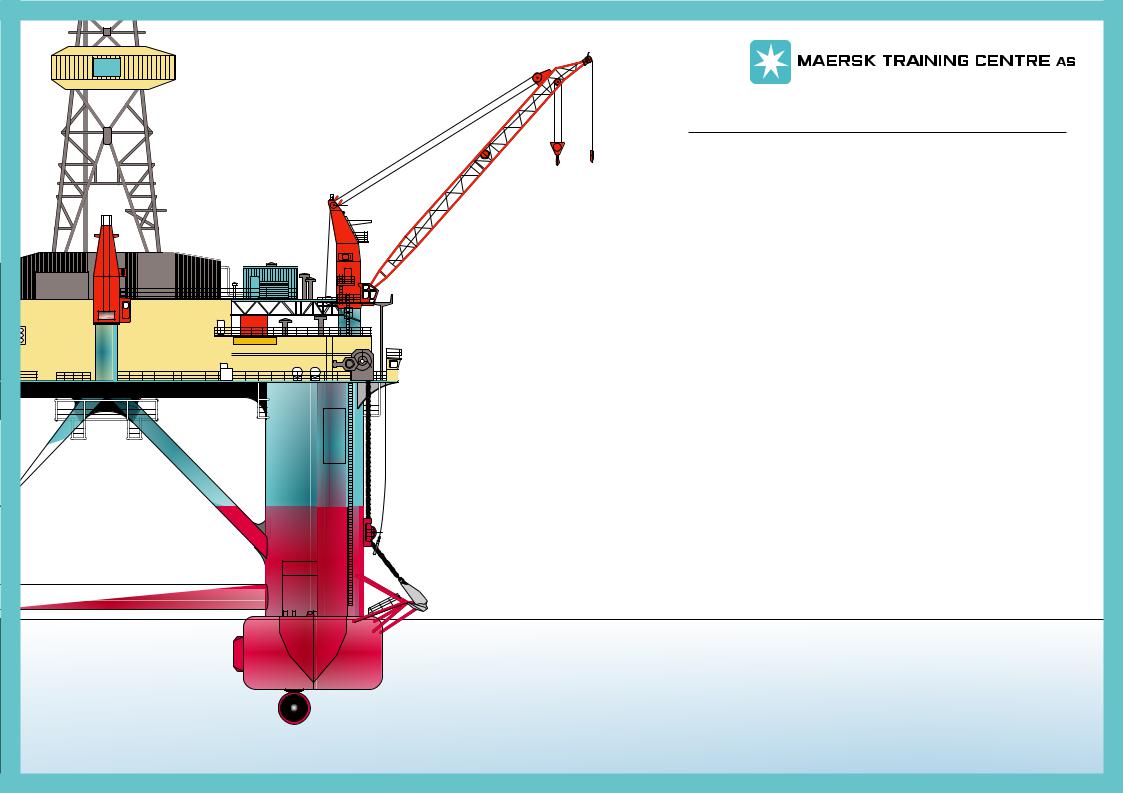
Anchor deployment, example of
DANMARK |
Polaris |
1 |
|
JK MultiMedie |
+45 6474 1995 |
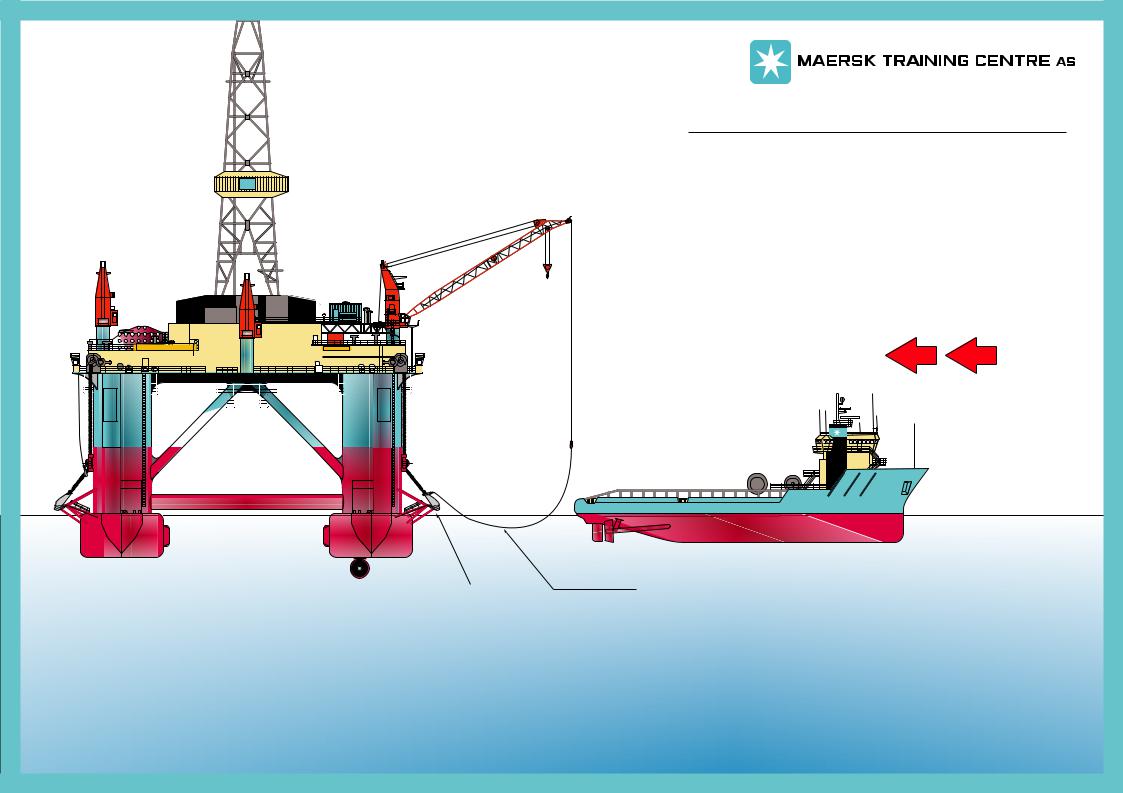
Anchor deployment, example of
• The Maersk Trainer will back up to rig.
• Rig passes over PCP to deck of the Maersk
Trainer using rig crane.
AHTS backs up to rig to recieve PCP on deck
POLARIS |
DANMARK |
|
POLARIS |
AHTS
PCP MAERSK TRAINER
15 mt (w/ chaser) Stewpris anchor
2
JK MultiMedie +45 6474 1995
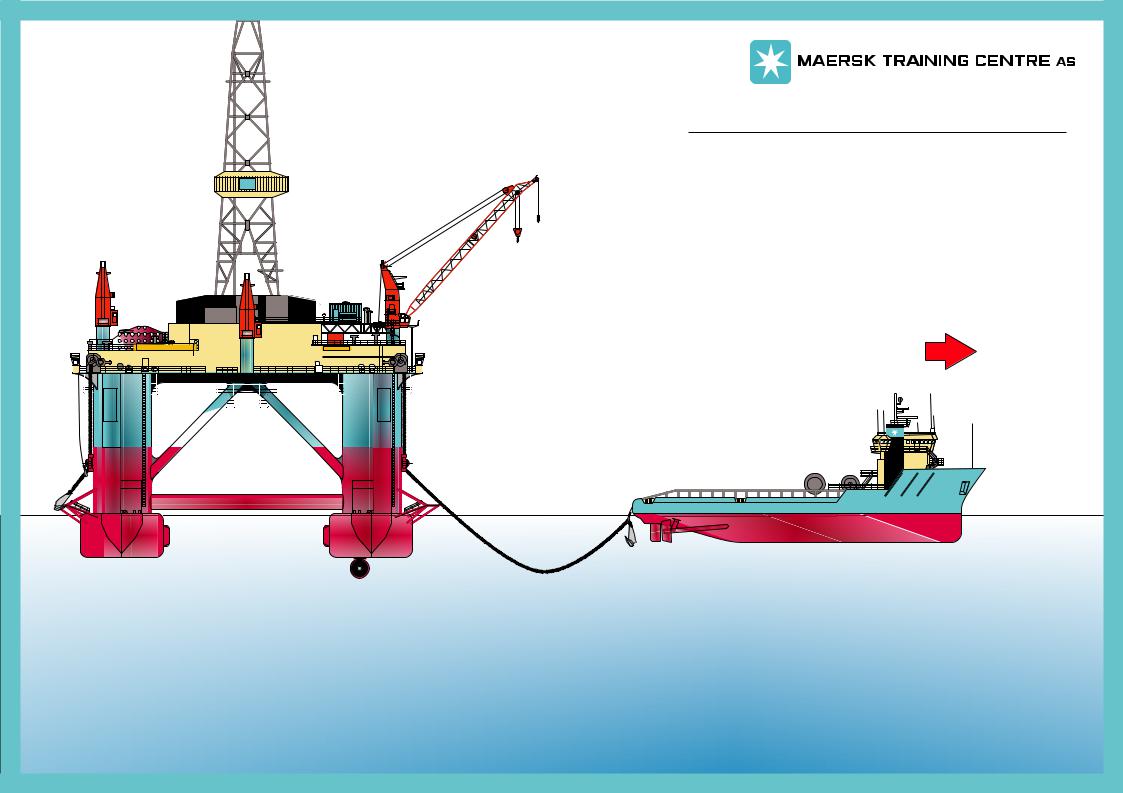
Anchor deployment, example of
POLARIS |
DANMARK |
|
POLARIS |
AHTS
MAERSK TRAINER
3
JK MultiMedie +45 6474 1995
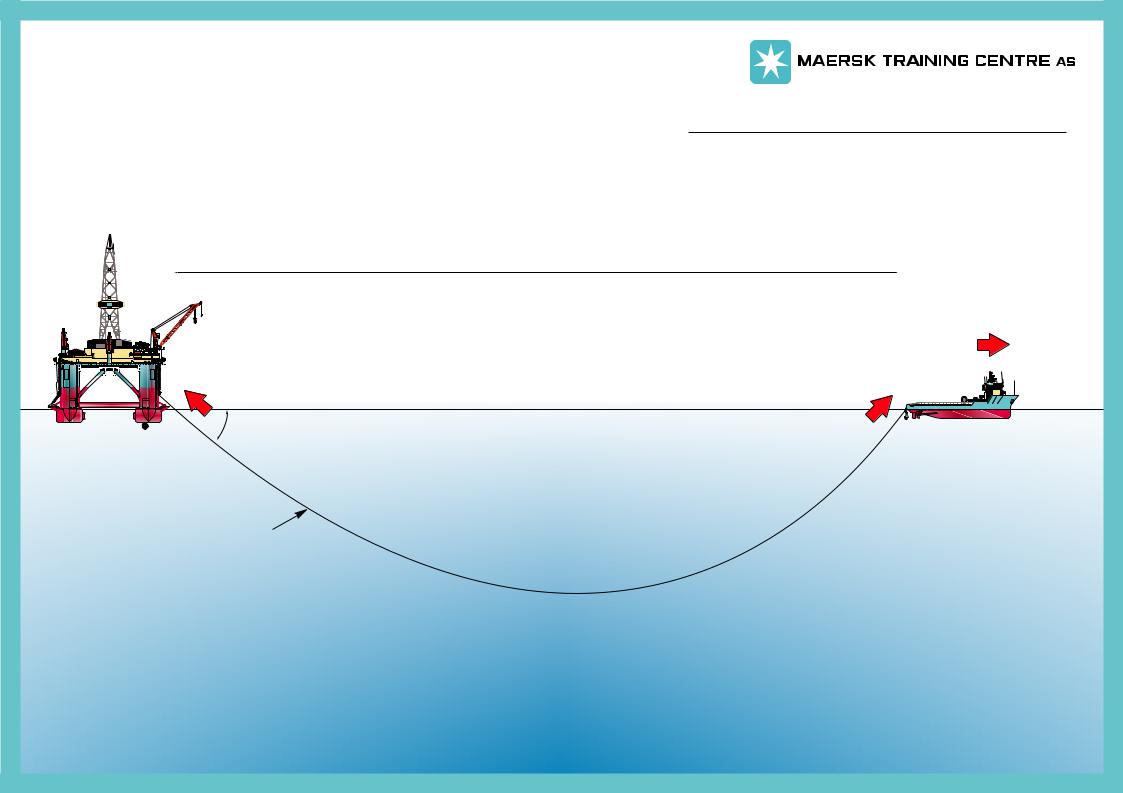
Anchor deployment, example of
• The rig will commence paying out all chain.
• The Maersk Trainer will be instructed to increase power to prevent mooring chain from rubbing on the rig’s anchor bolster.
~ 573 m
(Fairlead to stern roller horizontal distance)
~57 mt
POLARIS |
~75 mt |
~77 mt |
@ fairlead |
@ stern |
41.18° |
Maersk |
Polaris |
Trainer |
|
3 9⁄16" dia. x 609 m rig chain
4
JK MultiMedie +45 6474 1995
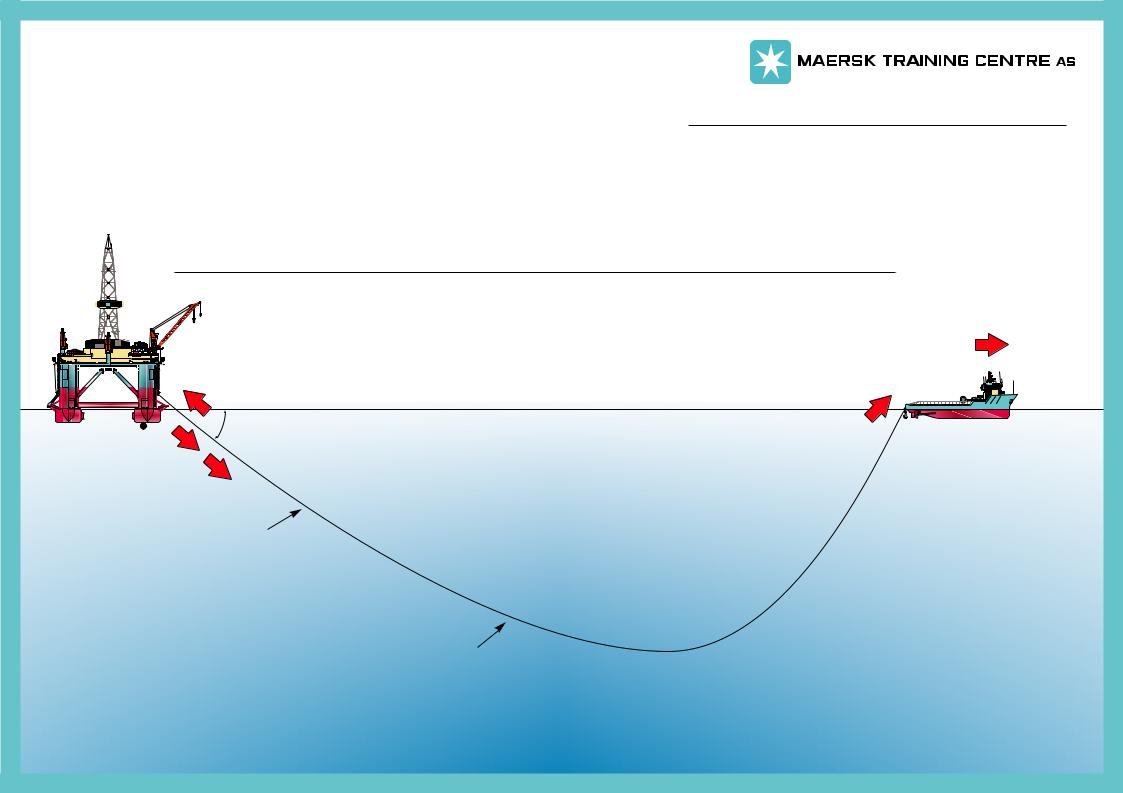
Anchor deployment, example of
•The Rig will pay out additional 500 meters of mooring wire and stop while AHTS keeps wire off bolster.
~ 1727 m
(Fairlead to stern roller horizontal distance)
~58 mt
POLARIS |
Polaris |
~91 mt |
~118 mt |
@ fairlead |
@ stern |
~41.74° |
AHTS |
|
Maersk |
|
Trainer |
3 1⁄2"dia. rig wire (~1000 m outboard)
3 9⁄16 dia. x 609 m rig chain
5
JK MultiMedie +45 6474 1995
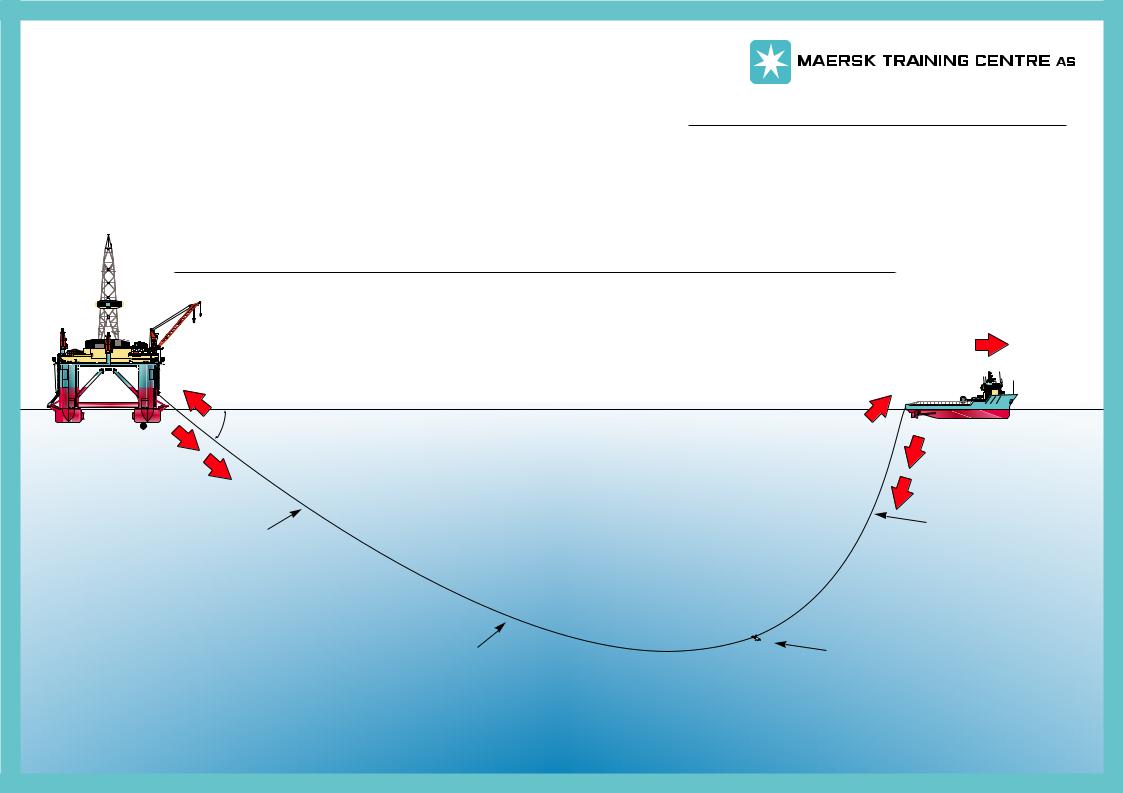
Anchor deployment, example of
•The Maersk Trainer pays 500 meters of work wire and keeps tension on system.
~ 1727 m
(Fairlead to stern roller horizontal distance)
~58 mt
POLARIS |
Polaris |
~91 mt |
~118 mt |
@ fairlead |
@ stern |
~41.74° |
AHTS |
|
Maersk |
|
Trainer |
|
3" dia. work wire |
3 1⁄2"dia. rig wire |
(~500 m outboard) |
(~1000 m outboard) |
|
3 9⁄16 dia. x 609 m |
15 mt |
rig chain |
Stewpris anchor |
|
5A
JK MultiMedie +45 6474 1995
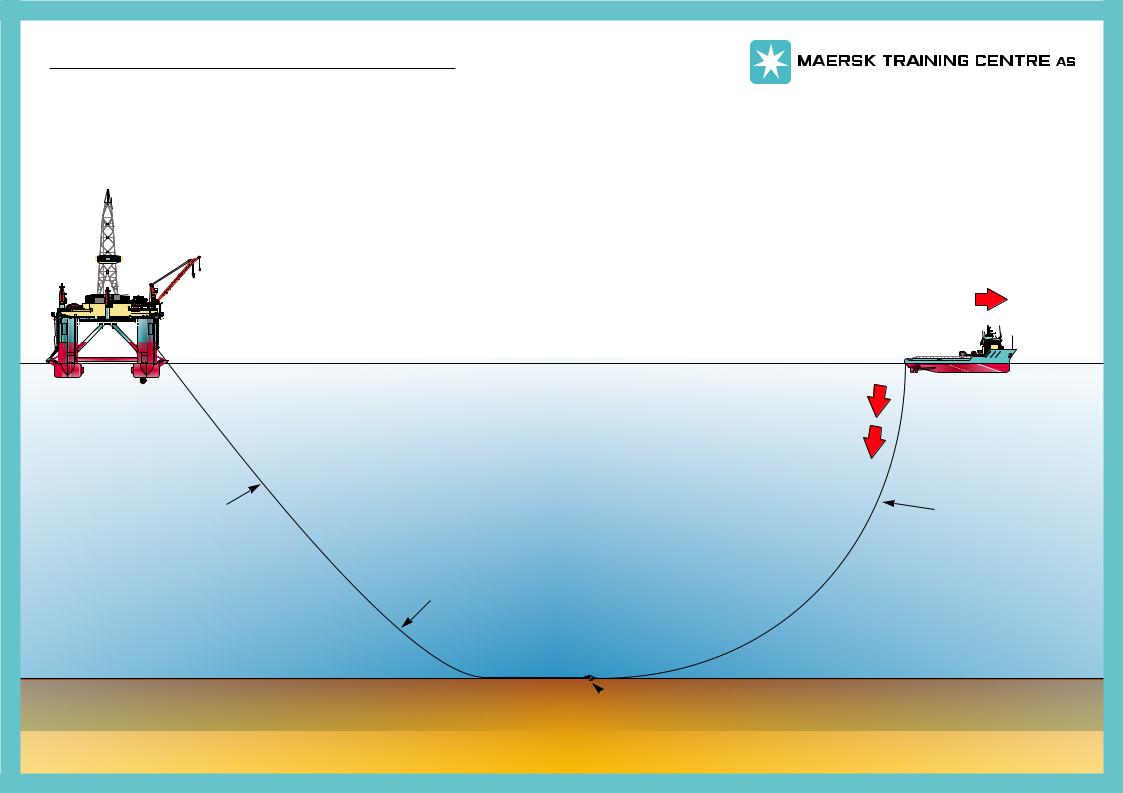
Anchor deployment, example of
•The Maersk Trainer will reduce power and pay out additional work wire equal to a total of 1.3 times the anchors water depth.
POLARIS |
Polaris |
AHTS |
|
Maersk |
||
|
||
|
Trainer |
3 |
1⁄2"dia. rig wire |
3" dia. work wire |
(~1638 m outboard) |
(~1981 m outboard)
3 9⁄16 dia. x 609 m rig chain
 15 mt
15 mt
Stewpris anchor
6
JK MultiMedie +45 6474 1995
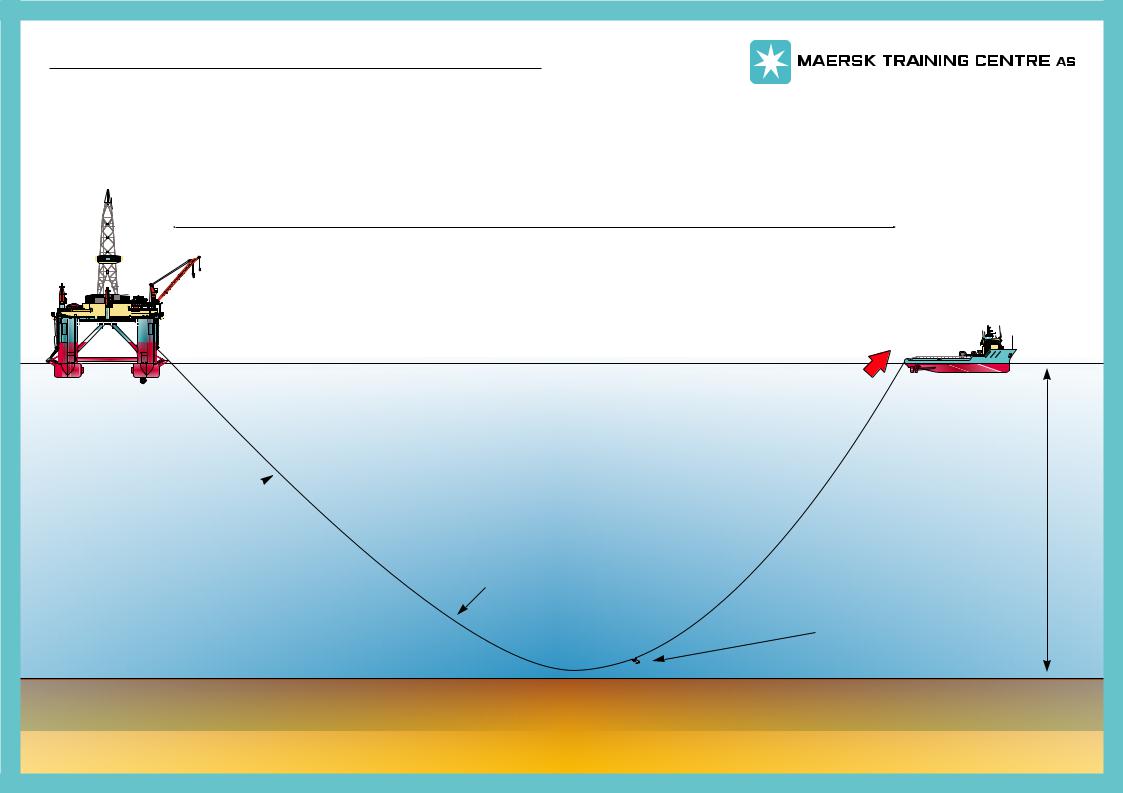
Anchor deployment, example of
•The Maersk Trainer will again increase power sufficiently to stretch mooring line to appox. 91 mt bollard pull.
•When the Rig has determined the mooring line has been stretched, the AHTS will be instructed to reduce power rapidly, thereby setting the anchor on bottom.
~ 3341 m
(Fairlead to stern roller horizontal distance)
POLARIS |
Polaris
AHTS
Maersk
Trainer
 3" dia. work wire
3" dia. work wire
 (~1638 m outboard) 3 1⁄2"dia. rig wire
(~1638 m outboard) 3 1⁄2"dia. rig wire
(~1981 m outboard)
Water Depth 1300 m
3 9⁄16 dia. x 609 m rig chain
15 mt Stewpris anchor
7
JK MultiMedie +45 6474 1995
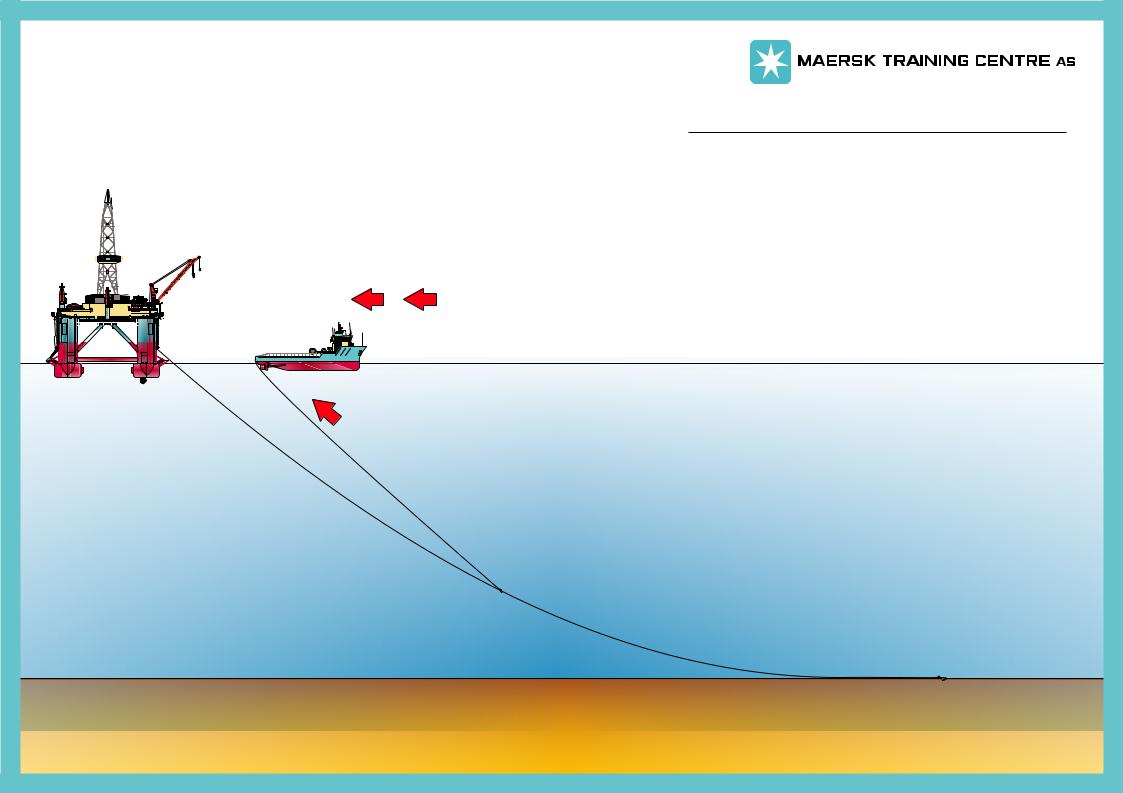
Anchor deployment, example of
• The Maersk Trainer returns to the rig with the PCP
POLARIS |
8
JK MultiMedie +45 6474 1995
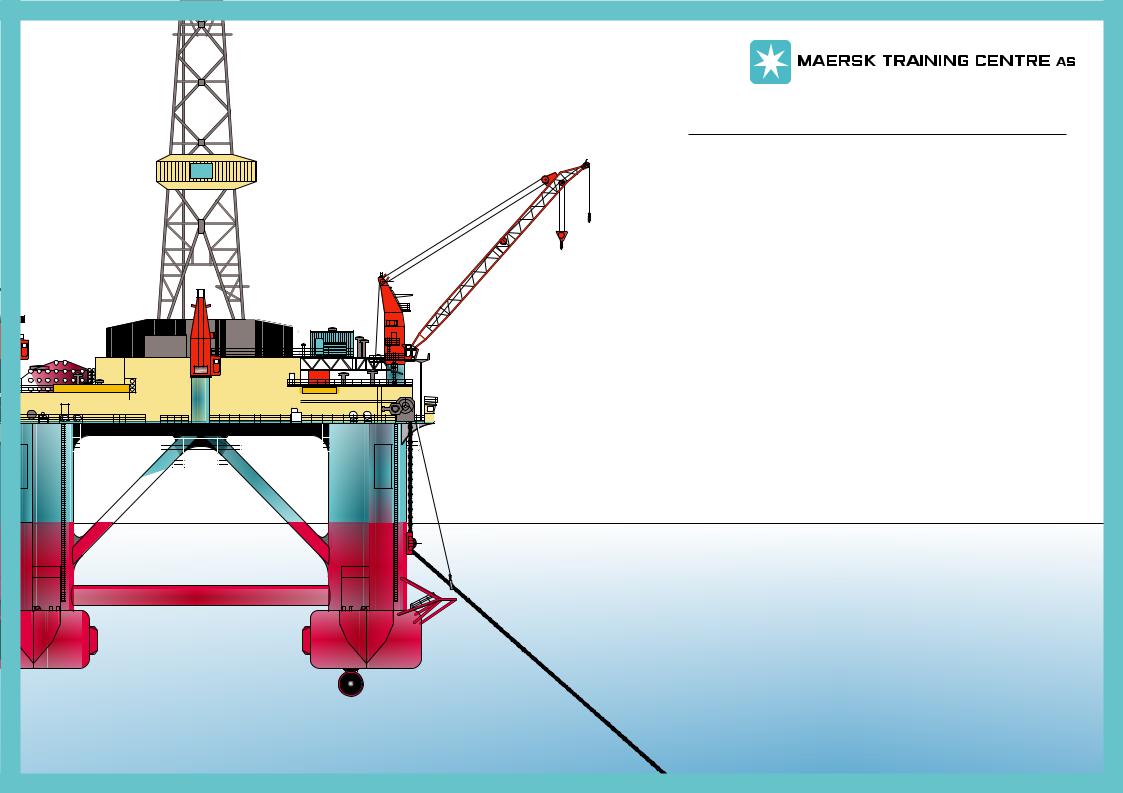
Anchor deployment, example of
POLARIS |
DANMARK |
9
JK MultiMedie +45 6474 1995
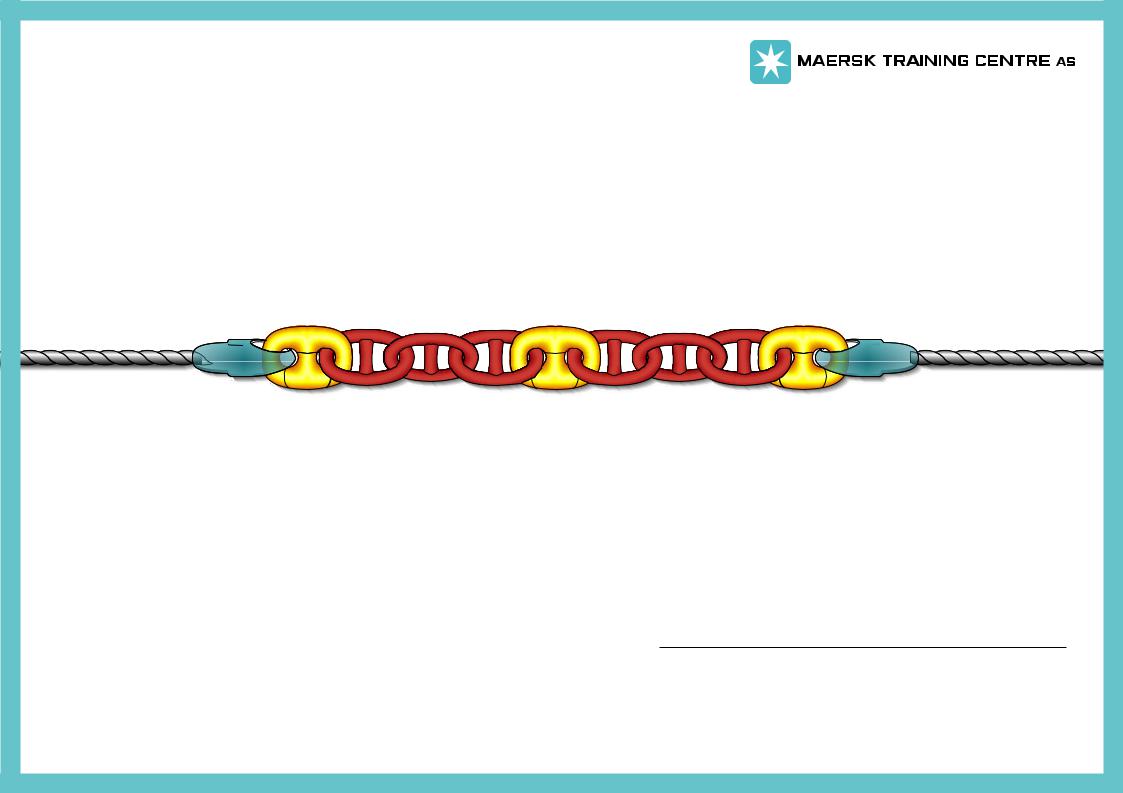
Anchor deployment, example of
• Pee Wee anchor pandant socket.
10
JK MultiMedie +45 6474 1995
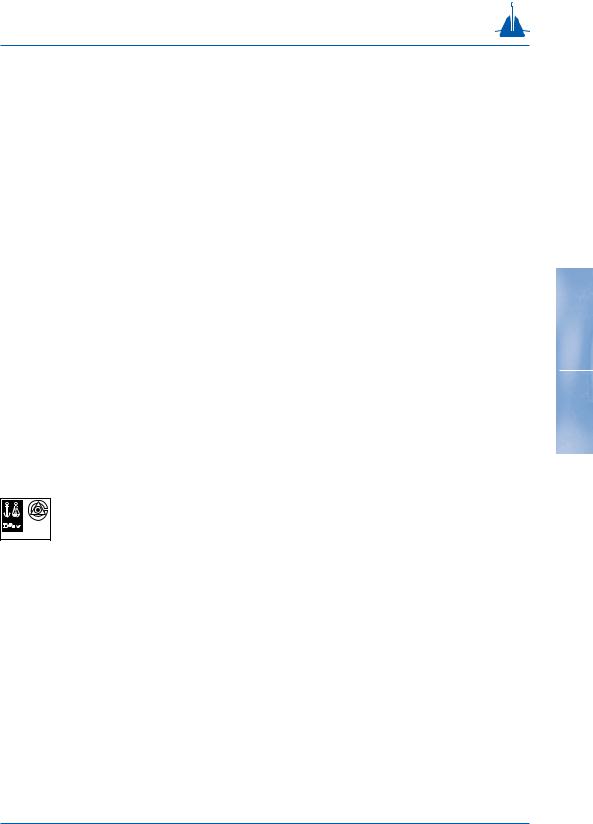
vryhof
anchor manual 2000
1
ACCREDITED BY
THE DUTCH COUNCIL
FOR CERTIFICATION
Reg. No 24
ISO-9001CERTIFICATED FIRM
DET NORSKE VERITAS INDUSTRY B.V., THE NETHERLANDS
Copyright
© Vryhof anchors b.v., krimpen a/d yssel, the netherlands 1999.
No part of this book may be reproduced in any form, by print, copy or in any other way without written permission of vryhof.
Vryhof, Stevin Mk3, Stevpris, Stevshark and Stevmanta are registered trade marks.
Vryhof reserves all intellectual and industrial property rights such as any and all of their patent, trademark, design, manufacturing, reproduction, use and sales rights thereto and to any article disclosed therein.
All information in this manual is subject to change without prior notice. Vryhof anchors is not liable and/or responsible in any way for the information provided in this manual.
First edition published 1984. Print run 7,500 copies.
Second edition published 1990. Print run 7,500 copies.
Reprint second edition print run 5,000 copies.
Third edition published 2000. Print run 2,500 copies.
